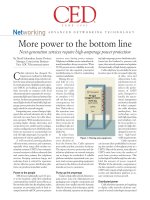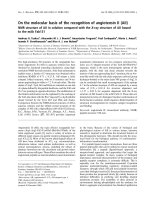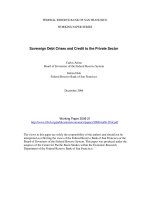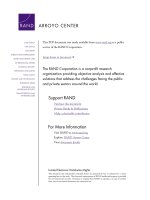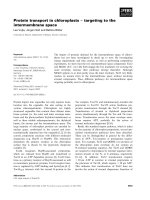economic re p ort presidentof thetransmitted to the congress february 2010 the annual report pptx
Bạn đang xem bản rút gọn của tài liệu. Xem và tải ngay bản đầy đủ của tài liệu tại đây (11.68 MB, 450 trang )
For sale by the Superintendent of Documents, U.S. Government Printing Oce
Internet: bookstore.gpo.gov Phone: toll free (866) 512-1800; DC area (202) 512-1800
Fax: (202) 512-2104 Mail: Stop IDCC, Washington, DC 20402-0001
ISBN 978-0-16-084824-7
:
iii
CONTENTS
ECONOMIC REPORT OF THE PRESIDENT 1
ANNUAL REPORT OF THE COUNCIL OF ECONOMIC ADVISERS* 11
CHAPTER 1. TO RESCUE, REBALANCE, AND REBUILD 25
CHAPTER 2. RESCUING THE ECONOMY FROM THE GREAT
RECESSION 39
CHAPTER 3 CRISIS AND RECOVERY IN THE WORLD
ECONOMY 81
CHAPTER 4. SAVING AND INVESTMENT 113
CHAPTER 5. ADDRESSING THE LONGRUN FISCAL
CHALLENGE 137
CHAPTER 6. BUILDING A SAFER FINANCIAL SYSTEM 159
CHAPTER 7. REFORMING HEALTH CARE 181
CHAPTER 8. STRENGTHENING THE AMERICAN LABOR
FORCE 213
CHAPTER 9. TRANSFORMING THE ENERGY SECTOR AND
ADDRESSING CLIMATE CHANGE 235
CHAPTER 10. FOSTERING PRODUCTIVITY GROWTH
THROUGH INNOVATION AND TRADE 259
REFERENCES 285
APPENDIX A. REPORT TO THE PRESIDENT ON THE
ACTIVITIES OF THE COUNCIL OF
ECONOMIC ADVISERS DURING 2009 305
APPENDIX B. STATISTICAL TABLES RELATING TO INCOME,
EMPLOYMENT, AND PRODUCTION 319
____________
*For a detailed table of contents of the Council’s Report, see page 15.
Page
Economic Report of the President | 3
T C U S:
As we begin a new year, the American people are still experiencing
the effects of a recession as deep and painful as any we have known in
generations. Traveling across this country, I have met countless men and
women who have lost jobs these past two years. I have met small business
owners struggling to pay for health care for their workers; seniors unable
to afford prescriptions; parents worried about paying the bills and saving
for their children’s future and their own retirement. And the effects of this
recession come in the aftermath of a decade of declining economic security
for the middle class and those who aspire to it.
At the same time, over the past two years, we have also seen reason
for hope: the resilience of the American people who have held fast—
even in the face of hardship—to an unrelenting faith in the promise of
our country.
It is that determination that has helped the American people
overcome difficult periods in our Nation’s history. And it is this persever-
ance that remains our great strength today. After all, our workers are as
productive as ever. American businesses are still leaders in innovation.
Our potential is still unrivaled. Our task as a Nation—and our mission
as an Administration—is to harness that innovative spirit, that productive
energy, and that potential in order to create jobs, raise incomes, and foster
economic growth that is sustained and broadly shared. It’s not enough
to move the economy from recession to recovery. We must rebuild the
economy on a new and stronger foundation.
I can report that over the past year, this work has begun. In the
coming year, this work continues. But to understand where we must go
in the next year and beyond, it is important to remember where we began
one year ago.
4 | Economic Report of the President
Last January, years of irresponsible risk-taking and debt-fueled
speculation—unchecked by sound oversight—led to the near-collapse
of our financial system. We were losing an average of 700,000 jobs each
month. Over the course of one year, $13 trillion of Americans’ household
wealth had evaporated as stocks, pensions, and home values plummeted.
Our gross domestic product was falling at the fastest rate in a quarter
century. The flow of credit, vital to the functioning of businesses large and
small, had ground to a halt. The fear among economists, from across the
political spectrum, was that we could sink into a second Great Depression.
Immediately, we took a series of difficult steps to prevent that
catastrophe for American families and businesses. We acted to get lending
flowing again so ordinary Americans could get financing to buy homes
and cars, to go to college, and to start businesses of their own; and so
businesses, large and small, could access loans to make payroll, buy equip-
ment, hire workers, and expand. We enacted measures to stem the tide of
foreclosures in our housing market, helping responsible homeowners stay
in their homes and helping to stop the broader decline in home values.
To achieve this, and to prevent an economic collapse, we were forced
to use authority enacted under the previous Administration to extend
assistance to some of the very banks and financial institutions whose
actions had helped precipitate the turmoil. We also took steps to prevent
the collapse of the American auto industry, which faced a crisis partly
of its own making, to prevent another round of widespread job losses in
an already fragile time. These decisions were not popular, but they were
necessary. Indeed, the decision to stabilize the financial system helped to
avert a larger catastrophe, and thanks to the efficient management of the
rescue—with added transparency and accountability—we have recovered
most of the money provided to banks.
In addition, even as we worked to address the crises in our banking
sector, in our housing market, and in our auto industry, we also began
attacking our economic crisis on a broader front. Less than one month
after taking office, we enacted the most sweeping economic recovery
package in history: the American Recovery and Reinvestment Act of
2009. The Recovery Act not only provided tax cuts to small businesses and
95 percent of working families and provided emergency relief to those out
of work or without health insurance; it also began to lay a new foundation
for long-term growth. With investments in health care, education, infra-
structure, and clean energy, the Recovery Act has saved or created roughly
two million jobs so far, and it has begun the hard work of transforming our
economy to thrive in the modern, global era.
Economic Report of the President | 5
Because of these and other steps, we can safely say that we’ve avoided
the depression many feared. Our economy is growing again, and the
growth over the last three months was the strongest in six years. But while
economic growth is important, it means nothing to somebody who has
lost a job and can’t find another. For Americans looking for work, a good
job is the only good news that matters. And that’s why our work is far
from complete.
It is true that the steps we have taken have slowed the flood of job
losses from 691,000 per month in the first quarter of 2009 to 69,000 in the
last quarter. But stemming the tide of job loss isn’t enough. More than
7 million jobs have been lost since the recession began two years ago. This
represents not only a terrible human tragedy, but also a very deep hole
from which we’ll have to climb out. Until jobs are being created to replace
those we’ve lost—until America is back at work—my Administration will
not rest and this recovery will not be finished.
That’s why I am continuing to call on the Congress to pass a jobs bill.
I’ve proposed a package that includes tax relief for small businesses to spur
hiring, that accelerates construction on roads, bridges, and waterways,
and that creates incentives for homeowners to invest in energy efficiency,
because this will create jobs, save families money, and reduce pollution
that harms our environment.
It is also essential that as we promote private sector hiring, we
continue to take steps to prevent layoffs of critical public servants like
teachers, firefighters, and police officers, whose jobs are threatened by
State and local budget shortfalls. To do otherwise would not only worsen
unemployment and hamper our recovery; it would also undermine our
communities. And we cannot forget the millions of people who have lost
their jobs. The Recovery Act provided support for these families hardest-
hit by this recession, and that support must continue.
At the same time, long before this crisis hit, middle-class families
were under growing strain. For decades, Washington failed to address
fundamental weaknesses in the economy: rising health care costs, growing
dependence on foreign oil, an education system unable to prepare all of
our children for the jobs of the future. In recent years, spending bills and
tax cuts for the very wealthiest were approved without paying for any of
it, leaving behind a mountain of debt. And while Wall Street gambled
without regard for the consequences, Washington looked the other way.
As a result, the economy may have been working for some at the
very top, but it was not working for all American families. Year after year,
folks were forced to work longer hours, spend more time away from their
6 | Economic Report of the President
loved ones, all while their incomes flat-lined and their sense of economic
security evaporated. Growth in our country was neither sustained nor
broadly shared. Instead of a prosperity powered by smart ideas and sound
investments, growth was fueled in large part by a rapid rise in consumer
borrowing and consumer spending.
Beneath the statistics are the stories of hardship I’ve heard all
across America—hardships that began long before this recession hit two
years ago. For too many, there has long been a sense that the American
dream—a chance to make your own way, to work hard and support your
family, save for college and retirement, own a home—was slipping away.
And this sense of anxiety has been combined with a deep frustration that
Washington either didn’t notice, or didn’t care enough to act.
These weaknesses have not only made our economy more
susceptible to the kind of crisis we have been through. They have also
meant that even in good times the economy did not produce nearly enough
gains for middle-class families. Typical American families saw their stan-
dards of living stagnate, rather than rise as they had for generations. That
is why, in the aftermath of this crisis, and after years of inaction, what is
clear is that we cannot go back to business as usual.
That is why, as we strive to meet the crisis of the moment, we are
continuing to lay a new foundation for prosperity: a foundation on which
the middle class can prosper and grow, where if you are willing to work
hard, you can find a good job, afford a home, send your children to world-
class schools, afford high-quality health care, and enjoy retirement security
in your later years. This is the heart of the American Dream, and it is at
the core of our efforts to not only rebuild this economy—but to rebuild it
stronger than before. And this work has already begun.
Already, we have made historic strides to reform and improve our
education system. We have launched a Race to the Top in which schools
are competing to create the most innovative programs, especially in math
and science. We have already made college more affordable, even as we
seek to increase student aid by ending a wasteful subsidy that serves only
to line the pockets of lenders with tens of billions of taxpayer dollars. And
I’ve proposed a new American Graduation Initiative and set this goal: by
2020, America will once again have the highest proportion of college grad-
uates in the world. For we know that in this new century, growth will be
powered not by what consumers can borrow and spend, but what talented,
skilled workers can create and export.
Already, we have made historic strides to improve our health care
system, essential to our economic prosperity. The burdens this system
Economic Report of the President | 7
places on workers, businesses, and governments is simply unsustainable.
And beyond the economic cost—which is vast—there is also a terrible
human toll. That’s why we’ve extended health insurance to millions more
children; invested in health information technology through the Recovery
Act to improve care and reduce costly errors; and provided the largest
boost to medical research in our history. And I continue to fight to pass
real, meaningful health insurance reforms that will get costs under control
for families, businesses, and governments, protect people from the worst
practices of insurance companies, and make coverage more affordable and
secure for people with insurance, as well as those without it.
Already, we have begun to build a new clean energy economy. The
Recovery Act included the largest investment in clean energy in history,
investments that are today creating jobs across America in the industries
that will power our future: developing wind energy, solar technology, and
clean energy vehicles. But this work has only just begun. Other countries
around the world understand that the nation that leads the clean energy
economy will be the nation that leads the global economy. I want America
to be that nation. That is why we are working toward legislation that will
create new incentives to finally make renewable energy the profitable
kind of energy in America. It’s not only essential for our planet and our
security, it’s essential for our economy.
But this is not all we must do. For growth to be truly sustainable—
for our prosperity to be truly shared and our living standards to actually
rise—we need to move beyond an economy that is fueled by budget deficits
and consumer demand. In other words, in order to create jobs and raise
incomes for the middle class over the long run, we need to export more
and borrow less from around the world, and we need to save more money
and take on less debt here at home. As we rebuild, we must also rebalance.
In order to achieve this, we’ll need to grow this economy by growing our
capacity to innovate in burgeoning industries, while putting a stop to irre-
sponsible budget policies and financial dealings that have led us into such
a deep fiscal and economic hole.
That begins with policies that will promote innovation throughout
our economy. To spur the discoveries that will power new jobs, new busi-
nesses—and perhaps new industries—I have challenged both the public
sector and the private sector to devote more resources to research and
development. And to achieve this, my budget puts us on a path to double
investment in key research agencies and makes the research and experi-
mentation tax credit permanent. We are also pursuing policies that will
help us export more of our goods around the world, especially by small
8 | Economic Report of the President
businesses and farmers. And by harnessing the growth potential of inter-
national trade—while ensuring that other countries play by the rules and
that all Americans share in the benefits—we will support millions of good,
high-paying jobs.
But hand in hand with increasing our reliance on the Nation’s
ingenuity is decreasing our reliance on the Nation’s credit card, as well as
reining in the excess and abuse in our financial sector that led large firms
to take on extraordinary risks and extraordinary liabilities.
When my Administration took office, the surpluses our Nation
had enjoyed at the start of the last decade had disappeared as a result of
the failure to pay for two large tax cuts, two wars, and a new entitlement
program. And decades of neglect of rising health care costs had put our
budget on an unsustainable path.
In the long term, we cannot have sustainable and durable economic
growth without getting our fiscal house in order. That is why even as we
increased our short-term deficit to rescue the economy, we have refused
to go along with business as usual, taking responsibility for every dollar we
spend. Last year, we combed the budget, cutting waste and excess wher-
ever we could, a process that will continue in the coming years. We are
pursuing health insurance reforms that are essential to reining in deficits.
I’ve called for a fee to be paid by the largest financial firms so that the
American people are fully repaid for bailing out the financial sector. And
I’ve proposed a freeze on nonsecurity discretionary spending for three
years, a bipartisan commission to address the long-term structural imbal-
ance between expenditures and revenues, and the enactment of “pay-go”
rules so that Congress has to account for every dollar it spends.
In addition, I’ve proposed a set of common sense reforms to prevent
future financial crises. For while the financial system is far stronger today
than it was one year ago, it is still operating under the same rules that led
to its near-collapse. These are rules that allowed firms to act contrary to
the interests of customers; to hide their exposure to debt through complex
financial dealings that few understood; to benefit from taxpayer-insured
deposits while making speculative investments to increase their own
profits; and to take on risks so vast that they posed a threat to the entire
economy and the jobs of tens of millions of Americans.
That is why we are seeking reforms to empower consumers with
the benefit of a new consumer watchdog charged with making sure that
financial information is clear and transparent; to close loopholes that
allowed big financial firms to trade risky financial products like credit
defaults swaps and other derivatives without any oversight; to identify
Economic Report of the President | 9
system-wide risks that could cause a financial meltdown; to strengthen
capital and liquidity requirements to make the system more stable; and to
ensure that the failure of any large firm does not take the economy down
with it. Never again will the American taxpayer be held hostage by a bank
that is “too big to fail.”
Through these reforms, we seek not to undermine our markets but
to make them stronger: to promote a vibrant, fair, and transparent finan-
cial system that is far more resistant to the reckless, irresponsible activities
that might lead to another meltdown. And these kinds of reforms are in
the shared interest of firms on Wall Street and families on Main Street.
These have been a very tough two years. American families and
businesses have paid a heavy price for failures of responsibility from Wall
Street to Washington. Our task now is to move beyond these failures, to
take responsibility for our future once more. That is how we will create
new jobs in new industries, harnessing the incredible generative and
creative capacity of our people. That is how we’ll achieve greater economic
security and opportunity for middle-class families in this country. That
is how in this new century we will rebuild our economy stronger than
ever before.
13
C E A
Washington, D.C., February 11, 2010
M. P:
The Council of Economic Advisers herewith submits its 2010
Annual Report in accordance of the Employment Act of 1946 as amended
by the Full Employment and Balanced Growth Act of 1978.
Sincerely,
Christina D. Romer
Chair
Austan Goolsbee
Member
Cecilia Elena Rouse
Member
15
CONTENTS
CHAPTER 1. TO RESCUE, REBALANCE, AND REBUILD 25
R E F 26
Rescuing the Economy from the Great Recession 28
Crisis and Recovery in the World Economy 29
R E P F
E
29
Saving and Investment 29
Addressing the Long-Run Fiscal Challenge 31
Building a Safer Financial System 32
R S E 33
Reforming Health Care 33
Strengthening the American Labor Force 35
Transforming the Energy Sector and Addressing Climate
Change
36
Fostering Productivity Growth Through Innovation and
Trade
37
C 38
CHAPTER 2. RESCUING THE ECONOMY FROM THE
GREAT RECESSION
39
A E F 39
The Run-Up to the Recession 40
The Downturn 41
Wall Street and Main Street 44
T U P R 46
Monetary Policy 47
Financial Rescue 49
Fiscal Stimulus 51
Housing Policy 55
T E P 56
Page
16 | Annual Report of the Council of Economic Advisers
The Financial Sector 57
Housing 60
Overall Economic Activity 63
The Labor Market 68
T C A 72
Deteriorating Forecasts 72
The Administration Forecast 75
Responsible Policies to Spur Job Creation 78
C 79
CHAPTER 3. CRISIS AND RECOVERY IN THE WORLD
ECONOMY
81
I D C 82
Spread of the Financial Shock 82
The Collapse of World Trade 87
The Collapse in Financial Flows 89
The Decline in Output Around the Globe 90
P R A G 93
Monetary Policy in the Crisis 93
Central Bank Liquidity Swaps 96
Fiscal Policy in the Crisis 98
Trade Policy in the Crisis 100
T R I I 100
The G-20 100
The International Monetary Fund 101
T B R A G 102
The Impact of Fiscal Policy 104
The World Economy in the Near Term 106
Global Imbalances in the Crisis 108
C 111
CHAPTER 4. SAVING AND INVESTMENT 113
T P C S 114
The Determinants of Saving 115
Implications for Recent and Future Saving Behavior 117
T F H M
C
120
The Housing Market 121
Contents | 17
Commercial Real Estate 123
B I 126
Investment in the Recovery 126
Investment in the Long Run 127
T C A 129
Determinants of the Current Account 129
The Current Account in the Recovery and in the Long Run 132
Steps to Encourage Exports 133
C 135
CHAPTER 5. ADDRESSING THE LONG-RUN FISCAL
CHALLENGE
137
T L-R F C 137
Sources of the Long-Run Fiscal Challenge 139
The Role of the Recovery Act and Other Rescue Operations 143
A A F P 144
The Effects of Budget Deficits 145
Feasible Long-Run Fiscal Policies 146
The Choice of a Fiscal Anchor 148
R F T 149
General Principles 149
Comprehensive Health Care Reform 150
Restoring Balance to the Tax Code 151
Eliminating Wasteful Spending 155
C: T D S G 156
CHAPTER 6. BUILDING A SAFER FINANCIAL SYSTEM 159
W I F I 160
The Economics of Financial Intermediation 160
Types of Financial Intermediaries 163
T R F I
U S
166
F C: T C F
I
170
Confidence Contagion 170
Counterparty Contagion 172
Coordination Contagion 173
P F C: R R 174
18 | Annual Report of the Council of Economic Advisers
Promote Robust Supervision and Regulation of Financial
Firms
175
Establish Comprehensive Regulation of Financial Markets 176
Provide the Government with the Tools It Needs to Manage
Financial Crises
178
Raise International Regulatory Standards and Improve
International Cooperation
179
Protect Consumers and Investors from Financial Abuse 179
C 180
CHAPTER 7. REFORMING HEALTH CARE 181
T C S U.S. H C S 182
Rising Health Spending in the United States 182
Market Failures in the Current U.S. Health Care System:
Theoretical Background
185
System-Wide Evidence of Inefficient Spending 188
Declining Coverage and Strains on Particular Groups and
Sectors
191
H P E 2009 196
Expansion of the CHIP Program 197
Subsidized COBRA Coverage 197
Temporary Federal Medical Assistance Percentage (FMAP)
Increase
199
Recovery Act Measures to Improve the Quality and Efficiency
of Health Care
201
2009 H R L 202
Insurance Market Reforms: Strengthening and Securing
Coverage
202
Expansions in Health Insurance Coverage Through the
Exchange
205
Economic and Health Benefits of Expanding Health
Insurance Coverage
206
Reducing the Growth Rate of Health Care Costs in the Public
and Private Sectors
207
The Economic Benefits of Slowing the Growth Rate of Health
Care Costs
210
C 211
Contents | 19
CHAPTER 8. STRENGTHENING THE AMERICAN
LABOR FORCE
213
C F A W 214
Unemployment 214
Sectoral Change 216
Stagnating Incomes for Middle-Class Families 217
P S W 219
E T: T G
L-T P
221
Benefits of Education 221
Trends in U.S. Educational Attainment 222
U.S. Student Achievement 226
A P T I E P 227
Postsecondary Education 228
Training and Adult Education 229
Elementary and Secondary Education 231
Early Childhood Education 233
C 234
CHAPTER 9. TRANSFORMING THE ENERGY SECTOR
AND ADDRESSING CLIMATE CHANGE
235
G G E, C, E
W-B
236
Greenhouse Gases 237
Temperature Change 238
Impact on Economic Well-Being 239
J-S T C E 243
Recovery Act Investments in Clean Energy 243
Short-Run Macroeconomic Effects of the Clean Energy
Investments
246
O D A M C
C
247
M-B A A C
E T A C C
248
Cap-and-Trade Program Basics 248
Ways to Contain Costs in an Effective Cap-and-Trade
System
250
20 | Annual Report of the Council of Economic Advisers
Coverage of Gases and Industries 253
The American Clean Energy and Security Act 254
I A C C I N 255
Partnerships with Major Developed and Emerging
Economies 256
Phasing Out Fossil Fuel Subsidies 257
C 257
CHAPTER 10. FOSTERING PRODUCTIVITY GROWTH
THROUGH INNOVATION AND TRADE
259
T R P G D L
S
261
Recent Trends in Productivity in the United States 262
Sources of Productivity Growth 264
F P G T I 266
The Importance of Basic Research 267
Private Research and Experimentation 269
Protection of Intellectual Property Rights 270
Spurring Progress in National Priority Areas 272
Increasing Openness and Transparency 272
T E P G
H L S
274
The United States and International Trade 275
Sources of Productivity Growth from International Trade 276
Encouraging Trade and Enforcing Trade Agreements 280
E G P G
A W S
282
C 284
REFERENCES 285
A. Report to the President on the Activities of the Council of
Economic Advisers During 2009
305
B. Statistical Tables Relating to Income, Employment, and
Production
319
Contents | 21
1-1. House Prices Adjusted for Inflation 27
1-2. Monthly Change in Payroll Employment 28
1-3. Personal Consumption Expenditures as a Share of GDP 30
1-4. Actual and Projected Budget Surpluses in January 2009
under Previous Policy
31
1-5. Real Median Family Income
33
1-6. Total Compensation Including and Excluding Health
Insurance
34
1-7. Mean Years of Schooling by Birth Cohort 36
1-8. R&D Spending as a Percent of GDP 37
2-1. House Prices Adjusted for Inflation 40
2-2. Income and Consumption Around the 2008 Tax Rebate 42
2-3. TED Spread and Moody’s BAA-AAA Spread Through
December 2008
43
2-4. Assets on the Federal Reserve’s Balance Sheet 48
2-5. TED Spread and Moody’s BAA-AAA Spread Through
December 2009
57
2-6. S&P 500 Stock Price Index 58
2-7. Monthly Gross SBA 7(a) and 504 Loan Approvals 60
2-8. 30-Year Fixed Rate Mortgage Rate 61
2-9. FHFA and LoanPerformance National House Price Indexes 63
2-10. Real GDP Growth 64
2-11. Real GDP: Actual and Statistical Baseline Projection 65
2-12. Contributions to Real GDP Growth 66
2-13. Average Monthly Change in Employment 68
2-14. Estimated Effect of the Recovery Act on Employment
69
2-15. Contributions to the Change in Employment 71
2-16. Okun’s Law, 2000-2009 74
3-1. Interbank Market Rates 83
3-2. Nominal Trade-Weighted Dollar Index 85
3-3. OECD Exports-to-GDP Ratio 87
3-4. Vertical Specialization and the Collapse in Trade 88
3-5. Cross-Border Gross Purchases and Sales of Long-Term
Assets
90
3-6. Industrial Production in Advanced Economies
91
3-7. Industrial Production in Emerging Economies 92
3-8. Headline Inflation, 12-Month Change 93
3-9. Policy Rates in Economies with Major Central Banks 94
22 | Annual Report of the Council of Economic Advisers
3-10. Change in Central Bank Assets 95
3-11. Central Bank Liquidity Swaps of the Federal Reserve
97
3-12. Tax Share and Discretionary Stimulus
99
3-13. Outperforming Expectations and Stimulus
105
3-14. OECD Countries: GDP and Unemployment 108
3-15. Current Account Deficits or Surpluses
110
4-1. Personal Consumption Expenditures as a Share of GDP 114
4-2. Personal Saving Rate Versus Wealth Ratio 115
4-3. Personal Saving Rate: Actual Versus Model 118
4-4. Actual Personal Saving Versus Counterfactual Personal
Saving
119
4-5. Single-Family Housing Starts 121
4-6. Homeownership Rate 122
4-7. Fixed Investment in Structures by Type 124
4-8. Commercial Real Estate Prices and Loan Delinquencies 125
4-9. Nonstructures Investment as a Share of Nominal GDP 128
4-10. Saving, Investment, and the Current Account as a Percent
of GDP
132
4-11. Growth of U.S. Exports and Rest-of-World Income:
1960-2008
134
5-1. Actual and Projected Budget Surpluses in January 2009
under Previous Policy
138
5-2. Actual and Projected Government Debt Held by the Public
under Previous Policy
139
5-3. Budgetary Cost of Previous Administration Policy 141
5-4. Causes of Rising Spending on Medicare, Medicaid, and
Social Security
142
5-5. Budget Comparison: January 2001 and January 2009 143
5-6. Effect of the Recovery Act on the Deficit 144
5-7. Top Statutory Tax Rates 153
5-8. Evolution of Average Tax Rates 154
6-1. Financial Intermediation: Saving into Investment 161
6-2. Financial Sector Assets
163
6-3. Share of Financial Sector Assets by Type 164
6-4. Confidence Contagion 171
6-5. Counterparty Contagion
173
6-6. Coordination Contagion
174
7-1. National Health Expenditures as a Share of GDP
183
7-2. Total Compensation Including and Excluding Health
Insurance
184
Contents | 23
7-3. Child and Infant Mortality Across G-7 Countries 190
7-4. Insurance Rates of Non-Elderly Adults 192
7-5. Percent of Americans Uninsured by Age 193
7-6. Share of Non-Elderly Individuals Uninsured by Poverty
Status
194
7-7. Medicare Part D Out-of-Pocket Costs by Total Prescription
Drug Spending
195
7-8. Share Uninsured among Adults Aged 18 and Over 198
7-9. Monthly Medicaid Enrollment Across the States 200
8-1. Unemployment and Underemployment Rates 214
8-2. Unemployment Rates by Race 215
8-3. Real Median Family Income and Median Individual
Earnings
218
8-4. Share of Pre-Tax Income Going to the Top 10 Percent of
Families
219
8-5. Total Wage and Salary Income by Educational Group
222
8-6. Mean Years of Schooling by Birth Cohort 224
8-7. Educational Attainment by Birth Cohort, 2007 225
8-8. Long-Term Trend Math Performance
227
9-1. Projected Global Carbon Dioxide Concentrations with No
Additional Action
238
9-2. Recovery Act Clean Energy Appropriations by Category 246
9-3. United States, China, and World Carbon Dioxide
Emissions
255
10-1. Non-Farm Labor Productivity and Per Capita Income 261
10-2. Labor Productivity Growth since 1947 262
10-3. R&D Spending as a Percent of GDP 270
10-4. Exports as a Share of GDP 275
10-5. Intra-Industry Trade, U.S. Manufacturing 278
2-1. Cyclically Sensitive Elements of Labor Market Adjustment 70
2-2. Forecast and Actual Macroeconomic Outcomes 73
2-3. Administration Economic Forecast 75
3-1. 2009 Fiscal Stimulus as Share of GDP, G-20 Members 98
3-2. Stimulus and Growth in Advanced G-20 Countries 104
5-1. Government Debt-to-GDP Ratio in Selected OECD
Countries (percent)
147
24 | Annual Report of the Council of Economic Advisers
2-1. Potential Real GDP Growth 76
4-1. Unemployment and the Current Account 130
7-1. The Impact of Health Reform on State and Local
Governments
208
8-1. The Recession’s Impact on the Education System 224
8-2. Community Colleges: A Crucial Component of Our
Higher Education System
230
9-1. Climate Change in the United States and Potential Impacts 240
9-2. Expected Consumption Loss Associated with Temperature
Increase
241
9-3. The European Union’s Experience with Emissions Trading 252
10-1. Overview of the Administration’s Innovation Agenda 266
285
REFERENCES
Chapter
To Rescue, Rebalance, and Rebuild
Congressional Budget Office. 2009a. The Budget and Economic Outlook:
Fiscal Years 2009 to 2019.
————. 2009b. The Long-Term Budget Outlook.
Goldin, Claudia, and Lawrence F. Katz. 2007. “Long-Run Changes in the
Wage Structure: Narrowing, Widening, Polarizing.” Brookings
Papers on Economic Activity, no. 2: 135–67.
Group of Twenty. 2009. “Leaders’ Statement: The Pittsburgh Summit.”
September 24–25 (www.g20.org/Documents/pittsburgh_summit_
leaders_statement_250909.pdf).
Kaiser Family Foundation and Health Research and Educational Trust.
2009. Employer Health Benefits: 2009 Annual Survey. Menlo
Park, CA, and Chicago, IL: Henry J. Kaiser Family Foundation and
Health Research and Educational Trust.
Shiller, Robert J. 2005. Irrational Exuberance. 2nd ed. Princeton University
Press.
Chapter
Rescuing the Economy from the Great Recession
Almeida, Heitor, et al. 2009. “Corporate Debt Maturity and the Real Effects
of the 2007 Credit Crisis.” Working Paper 14990. Cambridge, MA:
National Bureau of Economic Research (May).
286 | References
Bernanke, Ben S. 1983. “Nonmonetary Effects of the Financial Crisis in the
Propagation of the Great Depression.” American Economic Review
73, no. 3: 257–76.
Broda, Christian, and Jonathan Parker. 2008. “The Impact of the 2008 Tax
Rebates on Consumer Spending: Preliminary Evidence.” Working
Paper. University of Chicago, Graduate School of Business (July).
Campello, Murillo, John Graham, and Campbell R. Harvey. 2009. “The
Real Effects of Financial Constraints: Evidence from a Financial
Crisis.” Working Paper 15552. Cambridge, MA: National Bureau
of Economic Research (December).
Congressional Budget Office. 2009a. “Estimated Impact of the American
Recovery and Reinvestment Act on Employment and Economic
Output as of September 2009.” November.
————. 2009b. Letter to the Honorable Charles E. Grassley. “Estimated
Macroeconomic Impacts of the American Recovery and
Reinvestment Act of 2009.” March 2.
Council of Economic Advisers. 2009. “Economic Analysis of the Car
Allowance Rebate System (‘Cash for Clunkers’).” September.
————. 2010. “The Economic Impact of the American Recovery and
Reinvestment Act of 2009.” Second Quarterly Report to Congress.
January.
Gertler, Mark, and Simon Gilchrist. 1994. “Monetary Policy, Business
Cycles, and the Behavior of Small Manufacturing Firms.” Quarterly
Journal of Economics 109, no. 2: 309–40.
Kashyap, Anil K, Owen A. Lamont, and Jeremy C. Stein. 1994. “Credit
Conditions and the Cyclical Behavior of Inventories.” Quarterly
Journal of Economics 109, no. 3: 565–92.
Lamont, Owen A. 1997. “Cash Flow and Investment: Evidence from
Internal Capital Markets.” Journal of Finance 52, no. 1: 83–109.
Peek, Joe, and Eric S. Rosengren. 2000. “Collateral Damage: Effects of
the Japanese Bank Crisis on Real Activity in the United States.”
American Economic Review 90, no. 1: 30–45.
Rauh, Joshua D. 2006. “Investment and Financing Constraints: Evidence
from the Funding of Corporate Pension Plans.” Journal of Finance
61, no. 1: 33–71.
Rudebusch, Glenn D. 2009. “The Fed’s Monetary Policy Response to the
Current Crisis.” FRBSF Economic Letter 2009-17. Federal Reserve
Bank of San Francisco (May).
